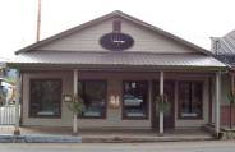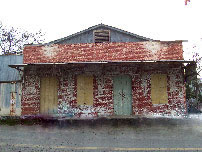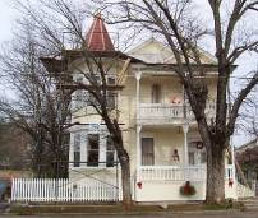![]()
 The first settlement in the area was called Pokerville, and was located about a mile or so downstream of the present town on Little Indian Creek. The camp was established around 1852, and as water was scarce and the placers stingy, the camp kind of faded away as the miners drifted upstream to a new site, a site which became known as Puckerville in 1855. This new camp proved to be more prosperous than the old, but not by much. A number of claims, with names such as the Southerland, the Aden, and the Simpson, were located about a mile east of town and as the years went by they helped the camp hold its own, neither booming nor busting, but surviving.
The first settlement in the area was called Pokerville, and was located about a mile or so downstream of the present town on Little Indian Creek. The camp was established around 1852, and as water was scarce and the placers stingy, the camp kind of faded away as the miners drifted upstream to a new site, a site which became known as Puckerville in 1855. This new camp proved to be more prosperous than the old, but not by much. A number of claims, with names such as the Southerland, the Aden, and the Simpson, were located about a mile east of town and as the years went by they helped the camp hold its own, neither booming nor busting, but surviving.
 Nothing of much excitement occurred in Pokerville or the surrounding area until 1871, when Alvinza Hayward purchased an interest in the Aden-Simpson, or “Plymouth Mine.” Hayward was a sharp mining man, having made a fortune in his mines in Sutter Creek and the Comstock Lode. He must have seen something worthwhile in the Plymouth. One of the results of this capital outlay was an increase in jobs. More jobs needed more men, and more men needed more places to spend their wages. Hotels, saloons, stores, and other places were men like to spend money were quickly constructed.
Nothing of much excitement occurred in Pokerville or the surrounding area until 1871, when Alvinza Hayward purchased an interest in the Aden-Simpson, or “Plymouth Mine.” Hayward was a sharp mining man, having made a fortune in his mines in Sutter Creek and the Comstock Lode. He must have seen something worthwhile in the Plymouth. One of the results of this capital outlay was an increase in jobs. More jobs needed more men, and more men needed more places to spend their wages. Hotels, saloons, stores, and other places were men like to spend money were quickly constructed.
 Pokerville grew, expanding to take care of these needs. And when the post office was established in September of 1871, with John J. Ekel as the postmaster, the place was known as Plymouth. When did the name change and for what reason? No one knows the answers to these and other questions, although they’re probably out there somewhere, in a diary lost or a forgotten copy of one of Plymouth’s early newspapers, the Independent or the Reporter. The name “Plymouth” appeared perhaps for the first time in 1856. It was applied to a quartz mill located on the north bank of Dry Creek, about a mile or so from the town of Puckerville. Maybe this is where the name came from.
Pokerville grew, expanding to take care of these needs. And when the post office was established in September of 1871, with John J. Ekel as the postmaster, the place was known as Plymouth. When did the name change and for what reason? No one knows the answers to these and other questions, although they’re probably out there somewhere, in a diary lost or a forgotten copy of one of Plymouth’s early newspapers, the Independent or the Reporter. The name “Plymouth” appeared perhaps for the first time in 1856. It was applied to a quartz mill located on the north bank of Dry Creek, about a mile or so from the town of Puckerville. Maybe this is where the name came from.
 Meanwhile, Hayward kept buying up ground and claims and by 1878 the Phoenix Mine—formerly the Plymouth—was producing $30,000 to $50,000 a month in gold. They sold the Phoenix that year, including its mill and a few of its ditches, to a New York corporation for $2 million. Renamed the Empire Mine, it was consolidated with a number of other claims in 1883, becoming the Plymouth Consolidated Mining Company, which operated until 1947.
Meanwhile, Hayward kept buying up ground and claims and by 1878 the Phoenix Mine—formerly the Plymouth—was producing $30,000 to $50,000 a month in gold. They sold the Phoenix that year, including its mill and a few of its ditches, to a New York corporation for $2 million. Renamed the Empire Mine, it was consolidated with a number of other claims in 1883, becoming the Plymouth Consolidated Mining Company, which operated until 1947.
The Old China Store is the most Gold Rush-esque building remaining in town. Although it was built in the 1880’s, it typifies the early day buildings of the Mother Lode. Constructed of brick and native stone, the store was fitted with the Gold Country’s trademark iron doors and shutters. A Chinese store was located here for many years, operated by Ming, the merchant. It stands alone at the west end of Main Street.
History copy from the internet site of www.AmadorGold.Net
 Integrity Design & Marketing
Integrity Design & Marketing
Rick Sanders
P.O. Box 22
Fiddletown, CA 95629
Ph. (209) 245-4900
email: rsanders@integritydm.com

